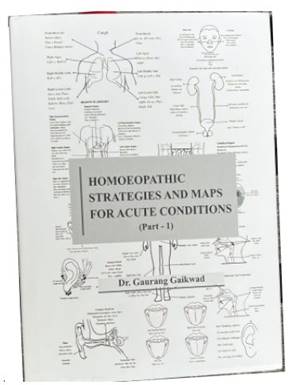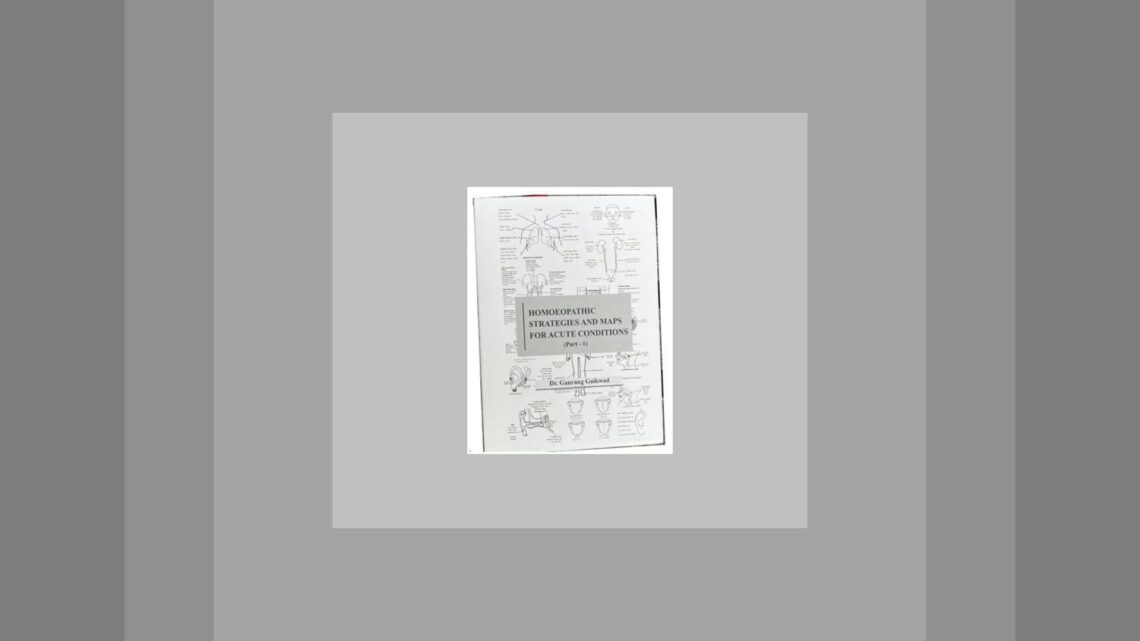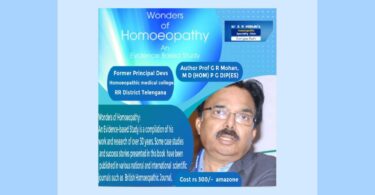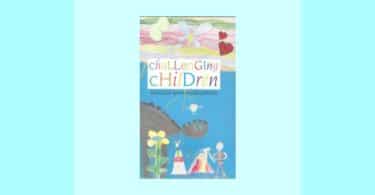Title: Homoeopathic Strategies and Maps For Acute Conditions Part 1
Author: Gaurang Gaikwad
Publisher: Homeopathy Healing, Mumbai, India, 2023
ISBN: 978-93-5701-069-6
Hard cover, 481 pages
Review by Vatsala Sperling

Growing up in India, my family had full access to our homeopath, and to him we trotted along for every acute illness that we got. There was never any question about taking antibiotic pills or injections. While our neighbors swallowed bitter pills, got jabbed repeatedly, and continued to get ill, we enjoyed great good health as a direct result of taking the remedies our childhood homeopath prescribed.
This experience prepared me for taking up homeopathy as my second career. And it also brought a huge smile to my face when I received Dr. Gaurang Gaikwad’s latest book, “Homoeopathic Strategies and Maps For Acute Conditions Part 1” for review.
A book such as this must be written over and over again by many different homeopaths from all over the world, because the effectiveness of homeopathy, in addressing acute illnesses, is essentially unparalleled. Books in this category, i.e., homeopathy for acute conditions, are both timeless, and priceless, and they show us the enormous potential of homeopathy for handling acute diseases.
Dr. Gaurang moved in the direction of writing this book as a result of his experience during the recent pandemic. Though homeopathy has a historical record of handling acute conditions, epidemics, and pandemics successfully, in his daily practice, he was facing challenges in treating COVID-related acute presentations.
Challenging situations brought out the best in him. He embraced the Zen idea, “The obstacle is the path”. He totally re-oriented himself to the foundation stones of homeopathy, i.e. individualization in each case, use of time-tested repertories, and verification of the indicated remedies in classic materia medicas.
This back-to-basics reorientation resulted in successful treatment of thousands of acute cases. At this point, he and his team came up with the idea of writing down the steps that helped them succeed. The result is this book, Homoeopathic Strategies And Maps For Acute Conditions Part 1. As the title shows, the book, totally based on practical experience, has easy to follow strategies and maps that help us in choosing remedies.
Part 1 covers case taking, case analysis, upper respiratory infections, throat infections, cough, fever, otitis, headache, gastric colic, renal colic, and diarrhea. There are brief cases at the end of each of these topics that help us see how the cases are handled without once looking away from the basic foundations of homeopathy, individualization, repertorization and materia medica.
The book reads like a quick how-to manual…how to use maps and strategies for getting where you need to go. No time and pages are wasted in verbose descriptions and explanations because what the author wants to convey is very readily expressed in maps and strategies.
Take for example, map of acute case taking on page 2. The readers can follow the map literally or subscribe to the idea that case taking is a “fluid process” and it begins from when and how the patient makes his appointment.
Besides following this fluid process, the practitioner must keep on observing his patients because direct observations give hints for choosing remedies too. This chapter on case taking is very interesting because Dr. Gaurang has presented each aspect of case taking with rubrics that clarify these aspects.
Once all observations are in place and we have completed the case taking process, then comes the labor-intensive part of case analysis. The author has recommended a few basic repertories, and highlighted their chief strengths, for example, Boericke’s repertory comes in very handy when strong pathology and clinical rubrics are present.
Besides Boericke’s, other repertories relied heavily by the author are, Phatak, Kent, Boger-Boenninghausen, Knerr, Clarke, Roberts, Dunham, Copperthwaite, Hughes, Nash, and Tyler. He is not shy about using more modern repertories as well, but the good old classics are his forte.
The chapters devoted to the acute diseases are very neat. They have a short definition of the disease in question, maps showing the location of symptoms and indicated remedies, common remedies as well as lesser-known remedies for each acute disease.
Take for example, the upper respiratory tract infections. In this chapter, maps show the location of symptoms like itching of eyelids, eyes, nose, upper palate, scalp, lower palate, ear, and throat; swollen turbinates, nasal polyps, postnasal drip, enlarged adenoids, and larynx-vocal cord polyps.
Additional maps show right and left sided coryza, concomitants for upper respiratory tract infections, remedies for dry and wet coryza, sneezing, concomitants, and anosmia. These maps are easy to memorize and recall, particularly if you are good with pictures in your mind.
Materia medica of the common and lesser-known remedies is a treat as well because these descriptions are short, and very practical. Key indications and rubrics complete the picture of the remedies. Case excerpts could not be anymore clear!
The cases are given in bullet points and analysis shows the author’s understanding of the cases and the rubrics that very astutely capture the full extent of the cases as presented. This is followed by remedy recommendation and a very brief follow up.
Precisely in the same manner, Dr. Gaurang has handled the chapters on other acute illnesses listed above.
What potency to choose for the acutes? Indications for choosing mother tincture, 3c, 6c, 30c, 200c, 1m, 10m, 50m, CM and LM are given in a brief table, pages 391-393, and a section on possible outcomes in a follow up help us determine what to do going forward.
There is a very interesting section on firsthand affirmations from the author’s assistants and associates. These associates work closely with Dr. Gaurang and watch him in action through all the cases that come to their clinic in Mumbai, India.
They also assist him in his online international cases. Each of these associates has expressed, by example of a case, that which taught him or her what the author has presented in the preceding chapters. This section reads like a testimonial.
At the end of the book, the author has given us, almost like a gift, a list of symptoms that could arise after fevers and vaccinations. This is particularly useful because during the pandemic, across the globe, in every country, people were vaccinated for common good, and many folks developed fever and other symptoms subsequently.
The most beautiful aspects of this book are that it is timely, to the point, and based on the day-to-day experience at a very busy clinic during the pandemic. This book takes us back to our roots in homeopathy, by way of encouraging us to stick with the time-tested repertories, materia medicas, and the very foundational principles of homeopathy. The vast amount of information summarized in maps, and strategies is rather easy to retain because of the manner of presentation.
For whom is this book written? In my view, it is written for anyone who has to do anything with homeopathy, students, enthusiasts, and practitioners, both young and old, of various homeopathic styles and systems. On another note, particularly in the West, there are some schools that teach brief foundational courses to mothers, as well as other groups of students who want to learn homeopathy for self-care at home.
For these students this book will open doors for a deeper understanding and practical application of what their school is trying to teach them. For me, personally, it will be a go-to quick book when I run into clients presenting with acute symptoms. I will also learn the intricate art of repertorization during acutes. Books offering such practical insights as seen in this book, are rare indeed and that makes me very keen about when part 2 of this title will be published. Hopefully, it will be soon.
Dr. Gaurang, Thank You very much for writing this book.







Where can we order?